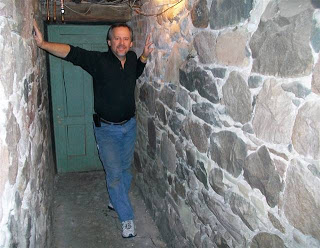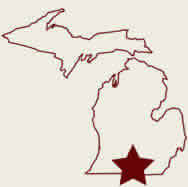More than a bed: B&Bs have ties to Underground Railroad – By Tanya Mohn – MSNBC – 02/01/2011
Relive history by staying at places thought to have been ‘stations’ or safe houses
 The Munro House bed and breakfast in Jonesville, Mich., has a 100-foot tunnel that was used as part of the Underground Railroad during slavery times and a trap door from the basement to a secret room between the first and second floors. “If you didn’t know it was there, you could never find it,” said innkeeper Mike Venturini.
The Munro House bed and breakfast in Jonesville, Mich., has a 100-foot tunnel that was used as part of the Underground Railroad during slavery times and a trap door from the basement to a secret room between the first and second floors. “If you didn’t know it was there, you could never find it,” said innkeeper Mike Venturini.Today, many are bed & breakfasts and everyone from history buffs to school children can relive history — especially during Black History month, which begins Feb. 1 — by staying at places thought to have been “stations” or safe houses on the Underground Railroad, an informal network that helped slaves escape to freedom.
Bringing it home
“It is kind of special to be so close to history,” said Vince Toreno, innkeeper at Ashley Manor Bed and Breakfast, in Barnstable, Mass., built in 1699, where a secret passageway connects the first and second floors to the attic. “Staying in a room so close to where a runaway slave might have been hiding and thinking ‘Am I going to live through until tomorrow? What’s going to happen to me?,’” Toreno said, “personalizes it, it brings it home.”
Visitors can see a ladder behind a secret panel in the Queen Charlotte Suite where the passageway begins, and a bookcase that swings open to reveal it in the King George Suite, on the second floor.
The Munro House, in Jonesville, Mich., has the remains of a 100-foot-long tunnel and a trap door from the basement to a secret room between the first and second floors. “If you didn’t know it was there, you could never find it,” said Mike Venturini, innkeeper, who regales guests with stories of how more than 400 runaway slaves allegedly hid in the secret room during a 15-year period on their way to Canada.
“Kids just love being in places out of the ordinary,” said Jared Maxwell, a teacher at nearby Williams Elementary School, where each year some 100 fourth grade students visit.
Lynne Smithwood grew up in the Samuel Fitch House in Westford, Mass., and with her five brothers played hide and seek in a basement tunnel believed to have been part of an escape route. Smithwood, now the innkeeper, said her childhood bedroom has a walk-in closet with a movable bookshelf that disguises a space where, according to family lore, slaves hid next to the warmth of the chimney. When she takes young guests exploring, “I give flashlights and big paintbrushes, to make sure there are no cobwebs in the way,” she said.
Educational overnight stays
The history was a surprise to Michael Rader, of Brookline, Mass., who stayed at the Samuel Fitch House recently with his daughter, Gavriel, 7, and son Adriel, 5. “We didn’t know anything about the house until we got there,” said Rader, who chose it because of its proximity to the Nashoba Valley Ski Area. “It was great,” especially for the children, who had “not yet been exposed to the Civil War or slavery,” he said. “We all learned something.”
Some B&Bs were not stations but are near historic sites, like the Harriet Beecher Stowe Center in Connecticut, the Harriet Tubman Museum in Maryland, and the National Underground Railroad Freedom Center in Cincinnati — built near the Ohio River, a popular route for escaping slaves.
Pennsylvania had many stops on the Underground Railroad, as Quakers were active participants. Visitors to the Lancaster area can attend “Living the Experience,” a spiritually inspired interactive re-enactment at the Bethel African Methodist Episcopal Church. “We try to highlight the role of faith and the church,” and to portray the strength and courage of the slaves who fled, said the Reverend Edward M. Bailey, the church’s pastor.
If you go …
Bedandbreakfast.com has a list of B&Bs thought to have been stations on the Underground Railroad or near historic sites.
For information about the Underground Railroad, visit freedomcenter.org.
The lessons of the Underground Railroad can help people today overcome adversity and become agents of change, said Katie Johnson, public programs manager at The Freedom Center, which recently opened a permanent exhibit, “Invisible: Slavery Today.” “Some of the numbers are shocking: between 12 and 27 million people are thought to be enslaved today,” Johnson said, including 17,500 people trafficked into the United States each year.
Many spaces where runaway slaves hid were originally built to store guns, hide valuables, or function as root cellars. Some spaces were thought to be hiding places during Indian raids or the Revolutionary War.
Reinforcing history’s important lessons
Because they were rarely built solely to help slaves, “it makes it very difficult to tell whether or not a home was a station on the Underground Railroad,” Johnson said, adding, “historical accounts backed by contemporary research have shown that there are many examples of these features being used for hiding escaping slaves.”
Some innkeepers say they have little if any proof that their B&Bs were once stations, but dates and ownership provide important clues.
Venturini, innkeeper of the Munro House, said the deed shows that the house was built during an active time of Underground Railroad activity in the pre-Civil War period by George Clinton Munro, a known abolitionist, and newspapers accounts of the era serve as further documentation.
“It’s exceedingly difficult to separate out what’s true and what’s not” said Ian Finseth, associate professor of English at the University of North Texas, specializing in 19th century American and African American literature.
While scholarship is important, visiting places where slaves may have stayed can reinforce important lessons of history. “By imagining the ghosts of people who didn’t make it and walking in the footsteps of people who did,” guests can “feel the human qualities of history,” said Finseth, who is also editor of “The Underground Railroad: Authentic Narratives and First-Hand Accounts,” a new abridged version of a book by William Still, originally published in 1872.
Pattye Benson, innkeeper of the Great Valley House of Valley Forge, Pa., recounted how such a visit once impacted a guest from Colorado, an elected official, who had her photo taken in front of the remains of a former tunnel believed to have sheltered slaves moving north. The woman used the photo for holiday cards, which she mailed to constituents. “She was really moved by the experience,” said Benson, who tells the house’s history to guests over breakfast in front of the walk-in fireplace, built circa 1690 (no cell phones allowed). “It was almost a sense of triumph.”
Debunking myths
Some B&Bs tell stories of how quilts were laid out to air but would also signal the home as a “safe house,” and how the interlocking patterns were coded maps to direct slaves.
But James O. Horton, professor emeritus of American studies and history at George Washington University, and other historians say the legend has been debunked. “There may have been some incident when someone, somewhere, used a quilt as a signal, but there is no historical evidence that there were elaborate quilt codes that helped many people escape from slavery.”
At the Amelia Island Williams House, in Fernandina Beach, Fla., a secret room, once accessible from a trap door in the dining room, is closed up now. But Deborah McCutchen, innkeeper, relishes telling guests how an earlier owner was “friends” with Jefferson Davis, president of the Confederacy during the Civil War. “While Davis may have been dining at the dinner table, slaves hid in the safe room,” she said.
In addition to learning about the Underground Railroad, many B&Bs offer other activities. Guests at the Williams House can visit the local museum, housed in an old jail, take horse-driven carriage rides to see the historic homes built in the 1800s, and walk to the nearby seaport. “It’s like taking all the historical parts of Savannah and Charleston and just putting them on a little island,” McCutchen said. “It’s just so beautiful.”
see the original article at © 2011 msnbc.com.
Mike Venturini
Jonesville Michigan Bed and Breakfast Innkeeper
“Life is good in Jonesville”


